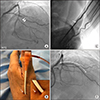A 69-year-old man was scheduled for coronary angiography (CAG) due to effort angina. CAG was performed via the left snuffbox approach using a 5-French (Fr) sheath (Radifocus® Introducer II; Terumo Corporation, Tokyo, Japan) and demonstrated a chronic total occlusion (CTO), 0 point of Japanese CTO score, in the left anterior descending artery (LAD) (Fig. 1A). The following day, gated myocardial single-photon emission computed tomography imaging demonstrated a significant reversible perfusion defect at the left ventricular apex; thus, percutaneous coronary intervention (PCI) was scheduled for the treatment of the CTO. Since the left distal radial artery was patent and the wound of the previous puncture site was clear, the same approach was used with a repuncture of the left distal radial artery, followed by the insertion of a 7-Fr. sheath (Fig. 1B). Peripheral angiography demonstrated no radial artery spasm after the insertion of the 7-Fr.sheath (Fig. 1C). Developed ipsilateral bridge collaterals at the CTO site led to anterograde approach for the CTO procedure without contralateral injection. Successful CTO intervention was achieved using a 2.75×19 mm and 2.5×40 mm bioabsorbable polymer sirolimus-eluting stent (BioMime, Life Sciences Pvt. Ltd., Vapi, India) after successful passage of a Gaia second guidewire (Asahi Intecc, Nagoya, Japan) with a microcatheter (Finecross™; Terumo, Tokyo, Japan) to the distal LAD using a extra backup type guiding catheter (RunWay™; Boston Scientific, Natick. MA, USA) (Fig. 1D). The patient was subsequently discharged without puncture-site bleeding complications after 6 hours of hemostasis using the compressive bandage method.
A coronary CTO intervention is the most challenging part of PCI field. Therefore, the feasibility of snuffbox CTO-PCI remain questionable as there are limited data regarding snuffbox PCI for complex lesions using a 7-Fr. sheath.12 With regard to repuncture of the distal radial artery, only 1 case report has been published.3 According to authors's experience, repuncture is not a difficult procedure if the patient has adequate pulsation of the distal radial artery. However, prospective studies are needed to confirm the safety and efficacy regarding repuncture of the distal radial artery. In terms of feasibility of 7-Fr. sheath and guiding catheter, there is only 1 published case report.4 It might be a good option to check the distal radial artery diameter by vascular ultrasonography to see if 7-Fr. sheath is suitable or not. This case highlights the feasibility of repuncture of distal radial artery and the snuffbox approach for complex PCI using a 7-Fr. sheath.




 PDF
PDF ePub
ePub Citation
Citation Print
Print



 XML Download
XML Download